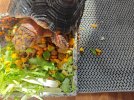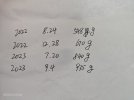Alex and the Redfoot
Well-Known Member
Yvonne would explain it better - she is one of the most experienced members here.
1. Sand (any type) is not good for tortoises, even mixed with soils. Avoid it. I think coconut coir would be better for the purpose (get it from a garden shop, its inexpensive).
2. From what I read, yes. This could happen from time to time and adult tortoise females may lay infertile eggs. I don't know how often it is and if there are females who don't lay eggs at all.
I really eager to know - as my tortoise is probably a female too
1. Sand (any type) is not good for tortoises, even mixed with soils. Avoid it. I think coconut coir would be better for the purpose (get it from a garden shop, its inexpensive).
2. From what I read, yes. This could happen from time to time and adult tortoise females may lay infertile eggs. I don't know how often it is and if there are females who don't lay eggs at all.
I really eager to know - as my tortoise is probably a female too


